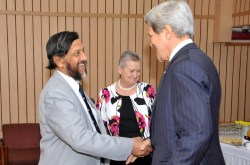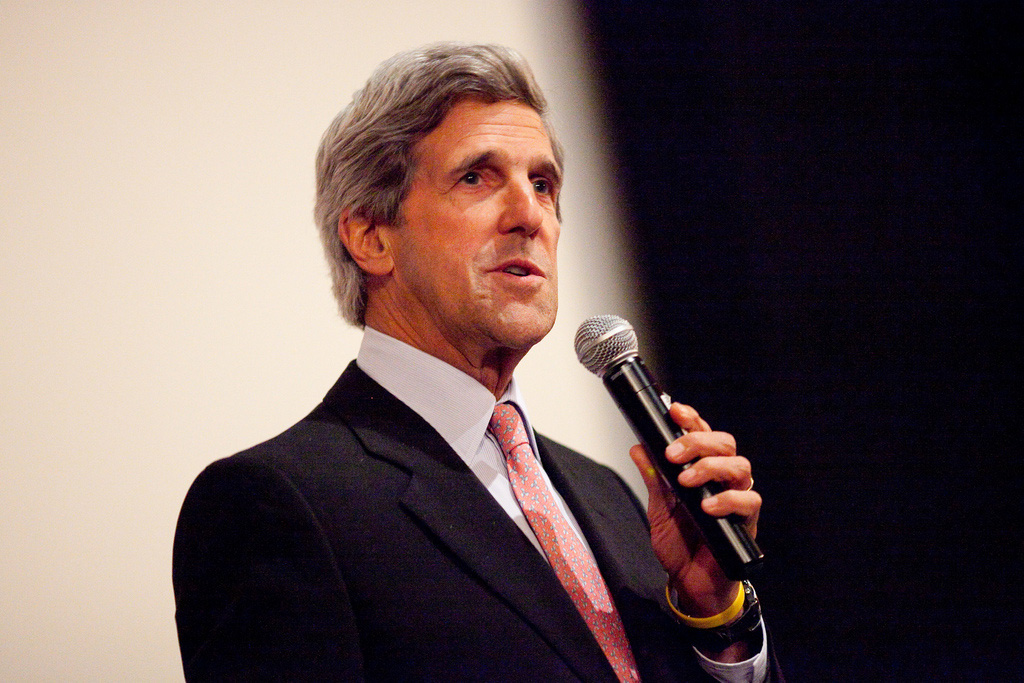
U.S. Embassy New DelhiIPCC Chairman Rajendra Pachauri, an Indian, welcomes John Kerry. That’s America’s ambassador to India, Nancy Powell, in the background.
U.S. Secretary of State John Kerry arrived in India over the weekend and gave a speech urging the fast-developing country to work closely with the U.S. and other countries on solutions to climate change.
Kerry is leading a delegation to Delhi for U.S.-India talks focused on trade and energy; Energy Secretary Ernest Moniz is part of the visiting group. The stop in Delhi is one leg of a trip Kerry is making throughout the region.
The Americans’ arrival in Delhi coincided with deadly floods in northern India that some Indian officials have linked to global warming. But though climate change poses urgent dangers in India, Kerry’s speech was not received warmly by all of the nation’s environmentalists. Some felt they were being lectured to by the secretary of state, a representative of a nation that is second only to China in total greenhouse gas emissions.
Kerry has long warned of the dangers of climate change, and it’s been one of his favorite topics to discuss abroad since he was sworn in as Obama’s top diplomat. “Everywhere I travel as secretary of state — in every meeting, here at home and across the more than 100,000 miles I’ve traveled since I raised my hand and took the oath to serve in this office — I raise the concern of climate change,” he wrote just last week in an opinion piece in Grist.
Kerry’s speech in India was part of a broader push by the Obama administration on climate change. The U.S. recently struck a deal with China to cooperate on reducing heat-trapping HFC emissions, and the president is preparing to make a big climate announcement on Tuesday.
The New York Times reports on Kerry’s speech:
“I do understand and fully sympathize with the notion that India’s paramount commitment to development and eradicating poverty [by increasing electricity supplies] is essential,” Mr. Kerry said in a speech at the start of a two-day visit. “But we have to recognize that a collective failure to meet our collective climate challenge would inhibit all countries’ dreams of growth and development.”
In an effort to prod the Indians to act, Mr. Kerry warned that climate change could cause India to endure excessive heat waves, prolonged droughts, intense flooding and shortages of food and water.
“The worst consequences of the climate crisis will confront people who are the least able to be able to cope with them,” he said. …
Mr. Kerry also pleaded with India to commit to working constructively on a global treaty to be negotiated under the United Nations Framework Convention on Climate Change.
Emerging economies like India have resisted pressure in global climate talks to commit to targets to reduce greenhouse gas emissions, in a dispute with rich nations over whose industries should bear the brunt of the cuts.
The 1.2 billion people who live in India use far less electricity than do Americans, but the nation’s growing economy and its dependance upon coal pose major global warming threats.
Chandra Bhushan, a senior official at the Delhi-based Centre for Science and Environment, was unimpressed by Kerry’s speech, as he explained in an opinion piece in Down to Earth, a leading Indian environmental magazine published by his nonprofit:
I have no problems with [Kerry’s] pitch for countries coming together to develop renewable energy. But I have issues with the fact that nowhere in his speech did he mention what the US is doing on renewable energy or what is the renewable energy target that the US has set for itself for, say 2020. The fact is that today close to 20 per cent of India’s electricity supply is from renewable sources (including hydropower). India has set itself a target for renewable energy; the US has not.
The US today is going the fossil fuel route. It is moving to shale gas big time. Kerry should know that this shale gas mania would destroy the renewable future of the world that he so fervently preached yesterday.
I found his speech hypocritical. He talked about how India should reduce its emissions from residential sector but gave the massive energy consumption in residential and commercial sectors in the US a convenient miss. The US is the largest consumer of HFCs in the world, but Kerry did not throw light on what the US is doing to phase out the highly potent greenhouse gas, and how quickly. While I agree that India should also phase out HFCs, … it should not be through a deal that only benefits American multinational companies.
Though Kerry’s comments might not have pleased everybody, they were delivered in a country that is being hit especially hard by global warming — and that needs to do more to tackle and adapt to it.
Climate change is causing India’s once-predictable monsoon to become erratic. It is pushing up temperatures in a region already known for its scorching summers. And it is melting glaciers that are relied upon by hundreds of millions of people for year-round water supplies.
Last year, the subcontinent’s annual summer monsoon arrived months late, parching farms and causing widespread blackouts by reducing hydroelectric supplies.
This year, the monsoon appears to have arrived early, and when it reached the country’s north, it collided with low-pressure troughs that had pushed unusually far south. That collision of weather systems triggered remarkable deluges. Resultant floods have killed at least 5,000 people in the Himalayan state of Uttarakhand. They also inundated Delhi’s international airport and pushed levels in the Yamuna River in the capital to their highest points since 1978.
Some Indian officials are saying climate change could be to blame for the flooding. There’s a paucity of scientific research into the possible effects of climate change on the nation, but some studies are underway. “We’re trying to assess the impacts of climate change on the regional climate and on the monsoons,” Indian Institute of Tropical Meteorology monsoon researcher Raghavan Krishnan told Grist. “We’re trying to look at extreme precipitation.”
While the research continues, it may be a good idea for India to take stock of the global warming impacts that are already understood and at least follow America’s lead by starting to break its nasty coal addiction.




